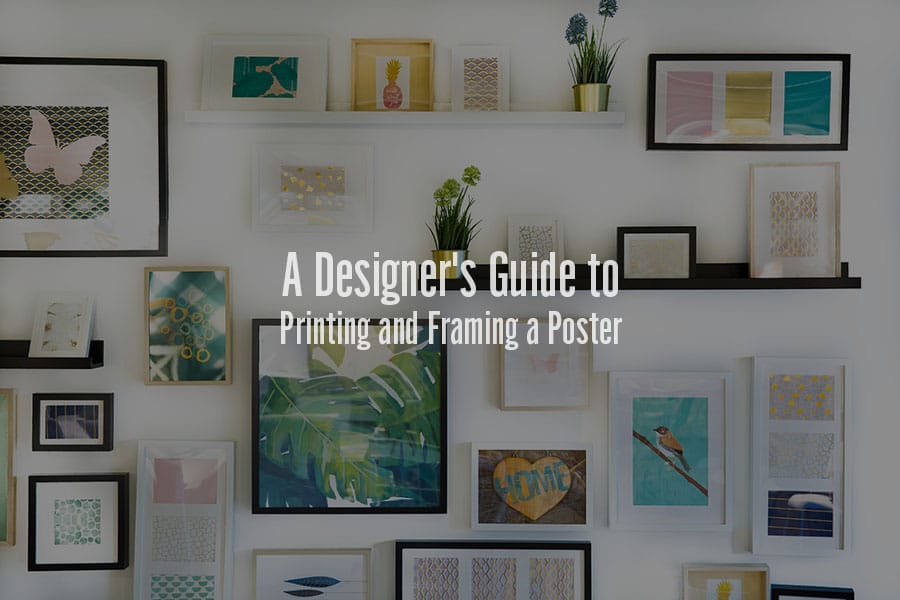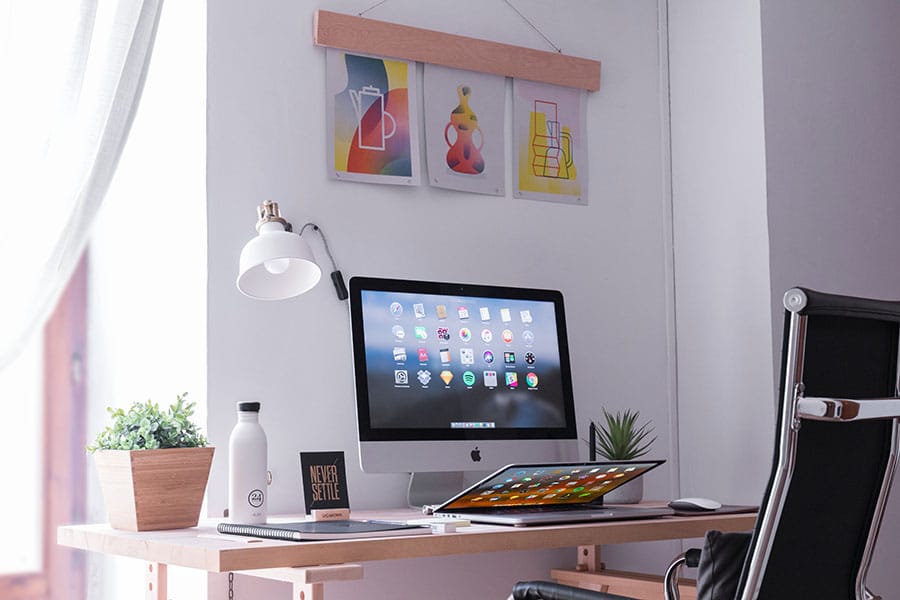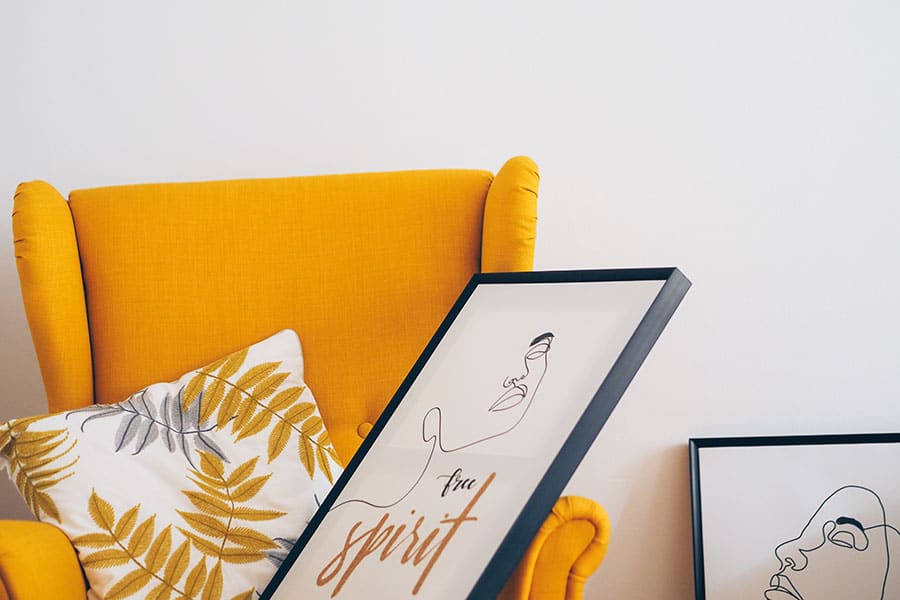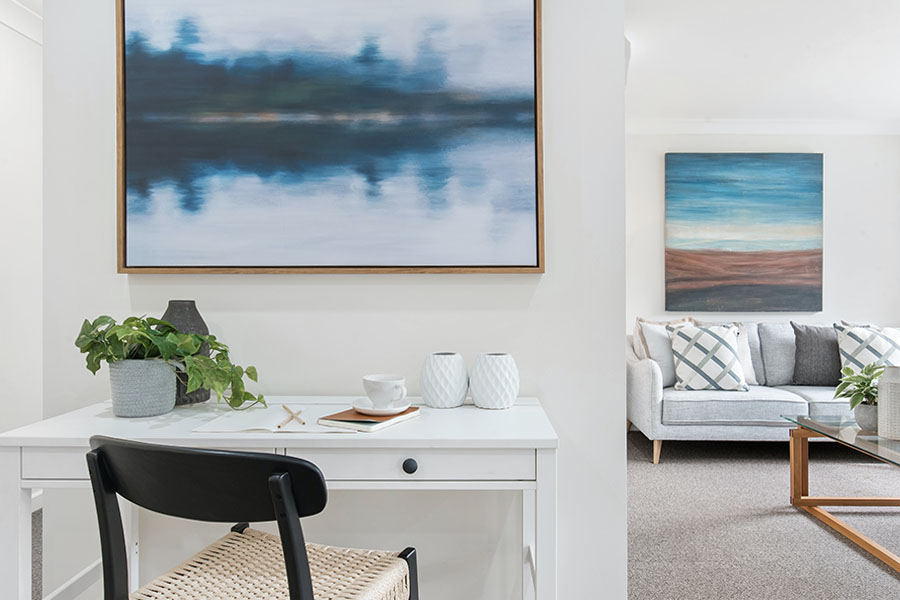Wall Art
A Designer’s Guide to Printing and Framing a Poster

No matter if you’re creating a curated photo wall, or simply want to update your living space, a beautifully printed and framed poster can make so much difference to your home!
If you don’t have any experience with framing posters, you might be unsure where to start – but this little guide has got you covered. I’ve put together my best tips to take you through the entire process – from selecting the right image quality to hanging your poster frame.
This way, updating your living space will be effortless, and you’ll get your walls looking like a Designer’s dream in no time!

Printing Your Poster
When it comes to printing your poster, there are a few different approaches to choose from. Here’s how to make sure you achieve the best image quality possible!

Printing at Home
Printing your own pictures doesn’t have to be daunting! It’s an excellent way to quickly change up your decor, and is surprisingly simple, too. Here are a few key pointers to follow:
Choose the Right Printable Files
In order to make sure your art prints look as high-class as possible, you’ll need to check your image files are high quality.
Image resolution indicates the number of pixels in an image file – the higher the number of pixels, the better quality your final poster will be!
If you’re looking for larger art prints, you’ll need to ensure your file has a good amount of pixels. If you’re looking for a poster that’s 16″ by 20″, then an image resolution of 1600×1200 is a good place to start. For anything larger, aim for 2000×2000 so that you don’t get caught out!
You should also double-check your image’s aspect ratio, and try to make sure that it matches your desired print size. For example, if your image is 2000×2000 then it has an aspect ratio of 1:1, so choosing print sizes with the same ratio will give you the best results – such as 16″ by 16″, or 20″ by 20″.
Finally, if you’re using an image or graphic that has been created using editing software, you should also check your image’s dots per inch (DPI). The DPI affects quality in a similar way to image resolution, so it’s best to aim for at least a 300 DPI for larger art prints and posters.
Select the Right Paper
Using the correct paper can add so much to an image, and can really help you set the mood for your living space.
If you’re looking for a traditional poster style, opt for gloss paper. It has a beautiful shine that will make your print’s colors pop, and looks great in most environments.
For a more artistic feel, consider using matte paper. It’s much more textured, and will help your images look great under harsher or less forgiving lights. Matte paper’s glare-free finish also makes it an excellent choice for those who want a monochrome color scheme, or are going to frame their art prints!
If you’re looking for a more gallery-style atmosphere, you may want to consider printing on canvas instead of paper! The smooth surface combines the benefits of matte and gloss paper, and will make sure your picture is the focal piece of any room.
No matter which paper type you choose – try your best to make sure it’s acid-free! Using acidic paper can actually speed up the aging of your poster, which is why the majority of archivists won’t use it. Acid-free paper is much less likely to interfere with your image, ensuring it looks better for longer.
Setting Borders
Choosing whether to add borders or bars to your print can come down to a variety of factors.
If you’re framing your print, you should always opt for a slight border. This way, your frame won’t hide part of your image, and the overall finish will look much more professional!
If you’ve already purchased a frame, but your image aspect ratio doesn’t quite match up – adding borders or bars can be a great solution that doesn’t require you distorting or heavily editing your photo in Photoshop!
Keep in mind that the majority of printers will automatically add a slight border to anything they print, so if you’ve decided to go for the borderless approach, don’t forget to double-check your device’s settings before you hit print!
Choosing the Best Printer
For most smaller posters, a standard printer should get the job done well. However, if you’re looking for a standard poster size print or bigger, you’ll need to have access to a large format printer. Many print shops will be happy to assist you, so it’s worth researching what’s available in your local area!
Regardless of how you choose to print your posters, keep in mind that the printing process can sometimes affect the final color range, leaving your prints looking slightly darker than on your computer screen. It is possible to calibrate your printer’s color range yourself, or you can discuss your options with local print shops if you need to!
When it comes to printer ink, you should avoid acid-based products as much as possible. The more acid in your supplies, the more your image will be affected – so choose acid-free products to keep your art print in great condition for as long as possible!
Ordering Art Prints Online
Printing your own images is a great option – but ordering online can sometimes be a little more convenient!
If you do decide to order online, taking the time to measure everything correctly can make the entire process much more efficient!
Firstly, double check your image size and aspect ratio. Ensure that your chosen file has a high number of pixels and dots per inch (DPI), so that it comes out looking great! Try to choose a print size that matches the aspect ratio of your image, but you can always discuss adding borders and bars to the print with your chosen vendor.
If you’ve already chosen a frame, or are trying to fill a specific spot on your photo wall, remember to measure which print size you’ll need, so that you don’t get caught out! Most print shops offer a range of different sizes, and will be happy to help you if you need a custom order, so it’s worth reaching out if you need to.
Finally, don’t forget to double-check which paper types you’ve chosen before you place your order. If you’re struggling to decide between matte and gloss, it’s always worth discussing it with your vendor, so that you can make sure your art prints really pop!

Framing Your Poster
Once you’ve received your finished posters, it’s time to frame them! Choosing the right frame styles can truly take your pictures to the next level, so here are a few tips to help ensure you’ve found the perfect one for your needs!
Ordering Frames Online
When it comes to ordering frames online, the most important thing to keep in mind is your image measurements!
It may seem simple, but the right size frame can not only make your poster look better, but help keep it safe, too.
Make sure to select a frame that’s slightly larger than the size of your print. Frames that are the exact same size as your picture can be difficult to use, and can even cause distortion or damage. Many people will opt for a frame that’s around an inch larger than the actual size of their print in both directions. This way, there’ll be a good border around the edges, but the frame won’t be so big that it distracts from the picture inside.
You also need to consider the amount of space between the front and back of your frame. If you’re using standard paper you shouldn’t have an issue, but if you’re printing on card or canvas it’s definitely a factor worth considering. Always double-check how much space your print will have inside the frame, and ensure there’s at least a few mm of space between your print and the front lens.
If you’re ever unsure, it’s always a good idea to reach out to the vendor!
Custom Made Frames
Visiting a local framer for custom frames can be a great experience, and it will help ensure you’ve chosen the right style for your poster, too!
Custom frames are an excellent choice if your poster is an unusual size, or if you’re looking to fill a specific space on your wall. Many framers will be happy to discuss poster frame sizing with you, and can even advise on whether to add borders to your artwork before it’s printed.
A framer will also be able to help you choose the best frame style for both your image and your home. If you’re not sure whether wood or metal is the right choice for your interior decoration project, they’ll be happy to offer advice, and give you customized recommendations, too!

D.I.Y Frames
If you’re looking for custom poster frames, but aren’t able to work with a local framer, then why not make them yourself?
Crafting D.I.Y frames is an excellent way to ensure your finished poster is a perfect match for your personal style, and it’s surprisingly easy, too.
Firstly, always measure the size of your print, as this will help you to work out how large your finished frame should be. The aperture or lens should be slightly larger than the image itself, whilst the size of the frame’s border is up to you! Don’t forget to account for your frame’s backboard, as it’s essential for making sure that your poster is secure, and won’t slip down once it’s on the wall.
Next, select your materials! It’s easy to make a classic wooden frame out of spare pieces of wood, or even an old window frame! If you prefer a metal finish, why not use some copper piping for a more industrial style? You can even embroider a frame made of fabric, or try crafting one from pottery clay if you’re working with a smaller print.
If you’re hoping to decorate your frame, keep in mind that you may have to make it slightly thicker, in order to ensure everything can fit. For poster frames that will be hung up, it’s best to opt for simpler, lighter designs that will be easier to hang. Ultimately, the possibilities really are endless! Designing your own frames allows you to utilize your existing skills, and craft something that perfectly suits your style!

Choosing the Right Frame Style
Once you’ve decided where to source your frames, the next step is deciding on a design. There are a few different approaches to take, so here are some handy framing tips that you might want to consider!
Image Size
It might seem simple, but the size of your image has a big effect on frame styles!
If you’re framing a larger poster, you might want to choose a frame with a slimmer border so that it doesn’t distract from the print inside. For smaller posters, a larger frame might help you to fill up space more easily, or allow your prints to make more of an impression!
Remember, a good general rule is to choose a frame that’s around an inch larger than the size of your print. Bigger frames can be a great choice, but going too large might cause your posters to get lost in their frames!
Image Style
Selecting a frame that compliments the style of your poster can be an excellent way to give your picture a sleek, curated finish.
For example, if your print has a clear color scheme, why not choose a frame to match? It can help enhance the shades in your poster, and make the whole room look more cohesive! If you’re looking for something a little more daring, you can always choose a frame in a contrasting shade – for example, a red frame can really make a green poster pop.
If your poster includes soft organic shapes, why not go for a rounder frame with curved edges to compliment the style of your piece? However, for more linear pieces, choose a minimal rectangular frame instead!
You might always want to consider how you’re arranging your posters. For a set of prints, choosing slimmer frames will enhance the artwork, and make it easier to appreciate the posters all together!
If you’re struggling to find a picture frame that perfectly matches the mood of your poster – don’t worry! It’s always worth taking your time to find that perfect piece, or simply going with a more timeless frame that blends in with the rest of your decor.
Room Type
Following the existing style of your room can often make choosing a poster frame much more simple!
If your home is fairly minimal, you may want to choose something that matches the poster frames you already own, or that reflects the accents of the room – such as wood or metal. For those looking for a more eclectic finish, choosing something a little more daring will work well!
If you’re feeling unsure, it’s a good idea to consider the function of the room you’re decorating. When you’re updating your home office, choose sleek metal frames to help add that professional touch. If you’re framing posters for your living room or family area, a poster frame that’s rounder and made from organic materials will create a cozier, softer atmosphere instead.
Ultimately, you know your own style best! Try to choose a picture frame you really love, because it will automatically work better with your vision for your completed space.
Frame Finish
That age-old question – “To matte or not to matte?” – can be really hard to answer, especially if you’re trying to choose a frame finish that compliments both your poster and your room!
Generally, matte, minimal posters work best in matte, minimal frames – whereas colorful posters look great in brighter, glossier frames! Simple, monochrome art prints are complimented perfectly by matte metal or wood frames, whereas eclectic pictures really pop in chrome metal or even glossy plastic surroundings!
Before you make your final decision, try to consider the other accents you’ve already used to decorate your room. If you’ve used lots of light-toned maple, oak, or ash, go for wood frames that match! If your home incorporates lots of copper, silver, or gold tones, select metal frames in a similar shade and finish.
If in doubt, go for something that will fit well with your existing decorations. The key to creating a perfectly curated home isn’t making sure everything matches exactly, but finding a few complementary pieces that you love!

Frames for Canvasses
Printing your poster on canvas can certainly help create a high-end, gallery-style atmosphere. Traditionally, canvas artwork was always given a frame – but many designers now opt not to frame their canvas posters at all!
A lot of people prefer the look of an unframed canvas, and enjoy how it appears to stand out against the walls. A professionally stretched canvas with well-wrapped edges is perfectly sleek enough to hang up, and can add a softer, more organic finish to the space.
However, if you’re looking to keep your poster in top condition for longer, choosing a frame might be a better option. A frame allows canvas artwork to blend in more seamlessly with the wall, and will help protect those wrapped edges from any wear and tear. There are a variety of canvas frame styles to suit any display preference, and you can even find more minimal designs that don’t take away from the print itself.
Ultimately, framing your canvas print will come down to personal preference. Poster frames do have their benefits, but it’s best to choose what is right for your home design goals!
Hanging Your Poster
Once you’ve printed your artwork and chosen the right poster frame, all that’s left to do is hang it up! Whether you’re unsure how exactly to hang your image, or are simply feeling uninspired, I’ve got you covered with my favorite poster-hanging tips!
Choosing Poster Frame Fastenings
Hanging your poster frame may seem daunting, but it doesn’t have to be!
When it comes to fastening photos to your walls, the most important factor to consider is how large your poster is.
If you’ve gone for a standard poster print size, you’ll most likely need to use nails or a hook, but the exact attachment type will depend on the hanging surface itself. If you’re not able to drill into your walls, you may be able to use adhesive hooks or strips. However, you should really take the time to ensure everything is secure, as you’ll need to use more adhesive to stop a heavier poster frame from falling.
For smaller posters, you won’t have to take as many precautions, as they’re less likely to fall and get damaged. Adhesive strips, nails, or hooks will all work well – and you can even use strong fishing wire or string to hang your poster instead!
If you’re unsure, you can always set your poster on top of a cabinet, and prop it against the wall!
Creating a Wall Art Gallery
Wall art galleries are the perfect way to add a focal point to a room, and really take your home design to the next level.
When it comes to selecting your art pieces, it’s a good idea to select a common theme. Whether that’s the color pink, photos of vintage coffee labels, or images related to your favorite city, your posters should have something that ties them all together.
Next, think about your arrangement. If you’re going for posters that are a uniform shape and size, a parallel, gallery-style arrangement will have the most impact. If your photos are a variety of shapes and sizes, hanging them in a collage style arrangement can really help bring them to life!
Your wall art gallery doesn’t have to be too ostentatious – just a few photos that mean something to you will work perfectly, no matter their shape or size. If you’d like any inspiration on the best prints for a specific room, you can find my favorite tips here.
Cover Photo by Jonny Caspari on Unsplash
2nd Photo by Christopher Burns on Unsplash
3rd Photo by Domenico Loia on Unsplash
4th Photo by Paige Cody on Unsplash
5th Photo by Debby Hudson on Unsplash
6th Photo by Laura Chouette on Unsplash
7th Photo by HausPhotoMedia.com on Unsplash

